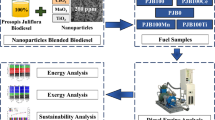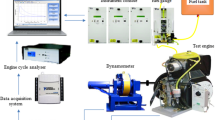Abstract
In this research, the effects of three operating parameters (Diesel injection timing, propane ratio, and exhaust gas recirculation (EGR) rates) in a diesel-propane dual fuel combustion were investigated. The characteristics of dual-fuel combustion were analyzed by engine parameters, such as emission levels (Nitrogen oxides (NOx) and particulate matter (PM)), gross indicated thermal efficiency (GIE) and gross IMEP Coefficient of Variance (CoV). Based on the results, improving operating strategies of the four main operating points were conducted for dual-fuel PCCI combustion with restrictions on the emissions and the maximum pressure rise rate. The NOx emission was restricted to below 0.21 g/kWh in terms of the indicated specific NOx (ISNOx), PM was restricted to under 0.2 FSN, and the maximum pressure rise rate (MPRR) was restricted to 10 bar/deg. Dual-fuel PCI combustion can be available with low NOx, PM emission and the maximum pressure rise rate in relatively low load condition. However, exceeding of PM and MPRR regulation was occurred in high load condition, therefore, design of optimal piston shape for early diesel injection and modification of hardware optimizing for dual-fuel combustion should be taken into consideration.
Similar content being viewed by others
References
Akihama, K., Takatori, Y., Inagaki, K., Sasaki, S. and Dean, A. (2001). Mechanism of the smokeless rich diesel combustion by reducing temperature. SAE Paper No. 2001-01-0655.
Choi, D., Jung, H., Chi, Y. and Joo, S. (2013). Diesel/Gasoline dual fuel powered combustion system based on diesel compression ignition triggered ignition control. SAE Paper No. 2013-01-1718.
Curran, S., Hanson, R., Wagner, R. and Reitz, R. (2013). Efficiency and emissions mapping of RCCI in a lightduty diesel engine. SAE Paper No. 2013-01-0289.
Curran, S., Prikhodko, V., Cho, K., Sluder, C. S., Parks, J., Wagner, R., Kokjohn, S. and Reitz, R. D. (2010). Incylinder fuel blending of gasoline/diesel for improved efficiency and lowest possible emissions on a multicylinder light-duty diesel engine. SAE Paper No. 2010-01-2206.
Dempsey, A. B., Walker, N. R. and Reitz, R. D. (2013). Effect of piston bowl geometry on dual fuel reactivity controlled compression ignition (RCCI) in a light-duty engine operated with gasoline/diesel and methanol/diesel. SAE Paper No. 2013-01-0264.
Hanson, R., Kokjohn, S., Splitter, D. and Reitz, R. (2011). Fuel effects on reactivity controlled compression ignition (RCCI) combustion at low load. SAE Paper No. 2011-01-0361.
Heywood, J. (1988). Internal Combustion Engine Fundamentals. McGraw-Hill. New York, USA.
Inagaki, K., Fuyuto, T., Nishikawa, K., Nakakita, K. and Sakata, I. (2006). Dual-fuel PCI combustion controlled by in-cylinder stratification of ignitability. SAE Paper No. 2006-01-0028.
Kimura, S., Aoki, O., Kitahara, Y. and Aiyoshizawa, E. (2001). Ultra-clean combustion technology combining a low-temperature and premixed combustion concept for meeting future emission standards. SAE Paper No. 2001-01-0200.
Kokjohn, S., Hanson, R., Splitter, D., Kaddatz, J. and Reitz, R. (2011). Fuel reactivity controlled compression ignition (RCCI) combustion in light-and heavy-duty engines. SAE Paper No. 2011-01-0357.
Krishnan, S. R., Srinivasan, K. and Raihan, M. S. (2016). The effect of injection parameters and boost pressure on diesel-propane dual fuel low temperature combustion in a single-cylinder research engine. Fuel, 184, 490–502.
Ladommatos, N., Abdelhalim, S. M., Zhao, H. and Hu, Z. (1998). Effects of EGR on heat release in diesel combustion. SAE Paper No. 980184.
Lee, J., Choi, S., Kim, H., Kim, D., Choi, H. and Min, K. (2013). Reduction of emissions with propane addition to a diesel engine. Int. J. Automotive Technology 14, 4, 551–558.
Lee, J., Chu, S., Cha, J., Choi, H. and Min, K. (2015). Effect of the diesel injection strategy on the combustion and emissions of propane/diesel dual fuel premixed charge compression ignition engines. Energy, 93, 1041–1052.
Li, Y., Jia, M., Liu, Y. and Xie, M. (2013). Numerical study on the combustion and emission characteristics of a methanol/diesel reactivity controlled compression ignition (RCCI) engine. Applied Energy, 106, 184–197.
Ma, S., Zheng, Z., Liu, H., Zhang, Q. and Yao, M. (2013). Experimental investigation of the effects of diesel injection strategy on gasoline/diesel dual-fuel combustion. Applied Energy, 109, 202–212.
Nieman, D., Dempsey, A. and Reitz, R. (2012). Heavyduty RCCI operation using natural gas and diesel. SAE Paper No. 2012-01-0379.
Ojeda, W., Zoldak, P., Espinosa, R. and Kumar, R. (2009). Development of a fuel injection strategy for partially premixed compression ignition combustion. SAE Paper No. 2009-01-1527.
Reitz, R. and Duraisamy, G. (2015). Review of high efficiency and clean reactivity controlled compression ignition (RCCI) combustion in internal combustion engines. Progress in Energy and Combustion Science, 46, 12–71.
Ryu, K. (2013). Effects of pilot injection timing on the combustion and emissions characteristics in a diesel engine using biodiesel–CNG dual fuel. Applied Energy, 111, 721–730.
Shibata, G. and Urushihara, T. (2010). Stabilizations of high temperature heat release CA50 and combustion period against engine load with the dosage of toluene in fuel. SAE Paper No. 2010-01-0575.
Zhang, Y., Sagalovich, I., De Ojeda, W., Ickes, A., Wallner, T. and Wickman, D. D. (2013). Development of dualfuel low temperature combustion strategy in a multicylinder heavy-duty compression ignition engine using conventional and alternative fuels. SAE Paper No. 2013-01-2422.
Author information
Authors and Affiliations
Corresponding author
Rights and permissions
About this article
Cite this article
Kang, J., Chu, S., Lee, J. et al. Effect of operating parameters on diesel/propane dual fuel premixed compression ignition in a diesel engine. Int.J Automot. Technol. 19, 27–35 (2018). https://doi.org/10.1007/s12239-018-0003-6
Received:
Revised:
Accepted:
Published:
Issue Date:
DOI: https://doi.org/10.1007/s12239-018-0003-6




